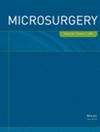Clinical effectiveness of postoperative prostaglandin E1 administration in reducing flap necrosis following microsurgical reconstruction
Abstract
Background
Extensive experimental evidence has suggested the potential efficacy of prostaglandin E1 (PGE1) in enhancing flap survival, leading to its widespread empirical use following free flap operation. However, the translation of these experimental findings into clinical benefits remains uncertain. This study aimed to assess the clinical effectiveness of postoperative PGE1 administration on the outcomes of microsurgical reconstruction.
Methods
A retrospective review was conducted for patients who underwent free flap-based reconstruction between September 2020 and November 2022, dividing into two cohorts. For all consecutive cases conducted during the formal half, PGE1 was administered for postoperative 7 days (PGE1 cohort), and for those during the latter, PGE1 was not given (non-PGE1 cohort). The profiles of perfusion-related complications (PRC) were compared between the two cohorts. Further analyses after propensity-score matching were performed.
Results
In total, 274 cases were analyzed, consisting of 142 in PGE1 and 132 in non-PGE1 cohort. Baseline characteristics were similar between the two cohorts, except for higher rates of comorbidities and chronic wound-related defects in the PGE1 cohort. Overall PRC developed in 37 cases (13.5%), including 6 (2.1%) total loss and 38 (10.2%) partial necrosis. Compared to the control, the PGE1 cohort exhibited significantly lower rates of overall PRC and partial flap necrosis. This difference remained significant on multivariable analyses. The rate of total flap loss did not differ between the cohorts. Consistent associations were observed in the propensity-score matching analysis.
Conclusion
Postoperative administration of PGE1 appears to be associated with reduced risks for the development of partial flap necrosis.

 求助内容:
求助内容: 应助结果提醒方式:
应助结果提醒方式:


